mobile Ansicht, to the English Version tap the flag
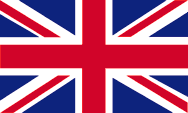

- Republik Kolumbien
- demokratische präsidiale Republik
- Eigenbezeichnung: República de Colombia
• Flaggen
• historische Flaggen
• Bedeutung/Ursprung der Flagge
• Wappen
• Bedeutung/Ursprung des Wappens
• Flugzeugkokarde
• Landkarte
• Zahlen und Fakten
• Geschichte
• Ursprung des Landesnamens
• San Andrés y Providencia

Nationalflagge,
Seitenverhältnis = 2:3,
Quelle, nach: Corel Draw 4





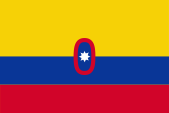
Handelsflagge,
Seitenverhältnis = 2:3,
Quelle, nach: Corel Draw 4



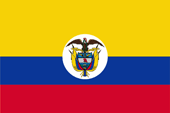
Marineflagge,
Seitenverhältnis = 2:3,
Quelle, nach: Flaggen und Wappen



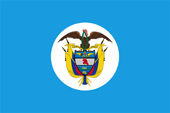
Gösch,
Seitenverhältnis = 2:3,
Quelle, nach: Wikipedia (DE)



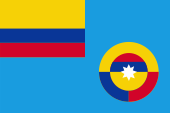
Flagge der Luftwaffe,
Seitenverhältnis = 2:3,
Quelle, nach: Flags of the World



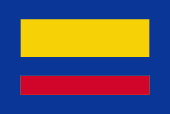
Zollflagge,
Seitenverhältnis = 2:3,
Quelle, nach:
Flags of the World, Flaggenbuch 1939



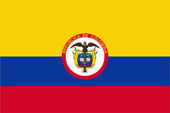
Präsidentenflagge,
Seitenverhältnis = 2:3,
Quelle, nach:
Flags of the World




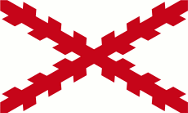
1538–1717,
Flagge Königreich Neu-Spanien,
Quelle, nach: Wikipedia (ES)




1717–1785,
Flagge Vize-Königreich Neu-Granada,
Quelle, nach: Wikipedia (EN)



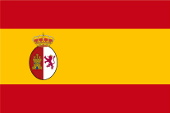
1785–1819,
Flagge Vize-Königreich Neu-Granada,
Quelle, nach: Wikipedia (EN)




1806–1815,
Flagge der aufständischen Regierung



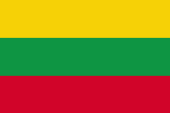
1814–1816,
Nationalflagge,
Quelle, nach: Wikipedia (EN)



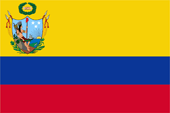
1819,
Nationalflagge von Großkolumbien,
Quelle, nach: Wikipedia (EN),
[CC BY-SA 4.0], via Wikimedia Commons



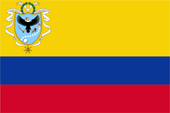
1820,
Nationalflagge von Großkolumbien,
Quelle, nach: Wikipedia (EN),
Milenioscuro [CC BY-SA 3.0], via Wikimedia Commons



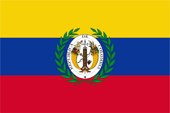
1821–1831,
Nationalflagge von Großkolumbien,
Quelle, nach: Wikipedia (EN),
Milenioscuro [CC BY-SA 3.0], via Wikimedia Commons



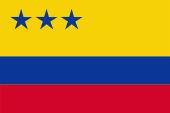
1822–1830,
allgemeine Nationalflagge von Großkolumbien,
Quelle, nach: Die Welt der Flaggen



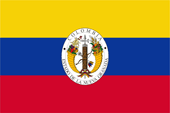
1831–1834,
Nationalflagge,
Seitenverhältnis = 2:3,
Quelle, nach: Wikipedia (EN),
Milenioscuro, CC BY-SA 3.0, via Wikimedia Commons



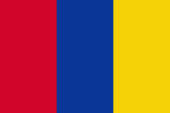
1834–1861,
Nationalflagge,
Seitenverhältnis = 2:3,
Quelle, nach: Wikipedia (EN)




1861,
Nationalflagge,
Seitenverhältnis = 2:3,
Quelle, nach: Wikipedia (EN)




Die Flagge Kolumbiens – in den Farben Gelb, Blau und Rot, und exat im heutigen Design – wurde 1806 durch Francisco de Miranda (1750–1816) eingeführt. Der breite gelbe Streifen sollte dazu dienen irgendwann ein Wappen oder eine raumgreifende Allegorie aufzunehmen. Seit dem Beginn des 19. Jahrhunderts wurde diese Flagge in verschiedenen, leicht abgewandelten Formen verwendet. Erstmals war sie bereits im Jahre 1807 bei einem Feldzug der Befreiungsarmee gegen Ortschaften im Norden Venezuelas in Gebrauch. Die Farben Gelb, Blau und Rot sollen die Trennung des Landes (Landesfarbe: Gelb) von der Kolonialmacht Spanien (Landesfarbe: Rot) durch das Meer (Blau) symbolisieren. Gelb steht auch für den Reichtum des Landes, für den Sonnenschein und die Kornfelder. Blau steht für den Himmel, den Ozean und die Flüsse, und Rot steht für das für die Unabhängigkeit vergossene Blut. Ekuador und Venezuela verwenden ähnliche Flaggen, ein Hinweis auf die einstige historische Vereinigung der Länder Ekuador, Venezuela und Kolumbien innerhalb Großkolumbiens. Die Flagge geht in ihre Farben auf Johann Wolfgang von Goethe zurück, der eine eigene Farbenlehre entwickelt hatte und Miranda 1785 in Weimar mit seinen Vorstellungen von Farben und ihren psychologischen Wirkprinzipien aufmerksam machte, und Gelb, Blau und Rot als die hauptsächlich vom Menschen wahrgenommenen Farben beschrieb. Miranda wählte als Farben Gelb, Blau und Rot. Häufig wird unterstellt, dass Miranda "Hellblau" gewählt hätte, was auch auf einigen Flaggendarstellungen aus dieser Region und Zeit zu finden ist. Das ist problematisch. Flaggen als historische Fundstücke werden oft mit dem modernen Auge betrachtet, und schnell wird eine bestimmte Farbbezeichnung verwendet. Dabei wird völlig ignoriert, dass das Hellblau auf Auswaschen und Verbleichen zurückzuführen ist, eine bei Indigo (einen anderen Farbstoff gab es damals noch nicht) bis heute bekannte und auch entsprechend ausgenutzte Eigenschaft. 1815 entschied man sich den Kampf gegen Spanien unter Flaggen in den Farben Gelb, Grün und Rot fortzusetzen. Im Jahre 1819 schlossen sich die Vereinigten Provinzen von Neugranada (das spätere Kolumbien) mit den Provinzen Quito (Ekuador) und Venezuela unter der Führung von Simón Bolívar zur Republik Großkolumbien zusammen. Dabei wurden die Farben Gelb, Blau und Rot wiederbelebt und für die Flagge des Landes übernommen, wieder mit dem breiten gelben Streifen, der jetzt in der Oberecke eine Allegorie mit einem sitzenden Indianer zeigte. Schon nach einem Jahr wurde das Wappen geändert, das blaue Schild zeigte jetzt einen Condor und mehrere Sterne. Nach einem Jahr, im Jahre 1821, wurde das Wappen wieder geändert. Es war jetzt eine Art Kartusche, die ein Liktorenbündel und zwei Füllhörner zeigte und ringsum den Namen des Landes. Es war jetzt in der Mitte der Flagge platziert, die nun drei gleich breite Streifen hatte. Dies Flagge wurde bis zum Ende Großkolumbiens im Jahre 1830 beibehalten. Das Land zerfiel nach dem Tod von Simón Bolívar in die Staaten Neugranada, Venezuela und Ekuador. Die Flagge Großkolumbiens wurde jedoch in der Praxis häufig ohne Wappen verwendet, das Obereck war ergänzt um drei blaue Sterne. Diese standen für die drei Provinzen Neugranada, Venezuela und Quito. Offenbar war diese Flagge leichter herzustellen. Das nach der Abtrennung von Ekuador und Venezuela verbleibende Restkolumbien nannte sich jetzt Neugranada, behielt jedoch die Flagge Großkolumbiens bei, nur wurde der Name des Landes in der Umschrift des Wappens geändert. Diese Flagge wurde nur bis 1834 verwendet. Danach wurden die Farben Gelb, Blau und Rot senkrecht angeordnet, ohne Wappen. Mit der Proklamation der Vereinigten Staaten von Kolumbien wurde im Jahr 1861 der blaue Mittelstreifen vier Monate lang um acht weiße Sterne ergänzt, die kreisförmig um einen neunten Stern in der Mitte angeordnet waren. Danach wurde wieder die Flagge von 1806 eingeführt, und bis heute beibehalten. In ihrer heutigen Gestalt wurde die Flagge am 26.11.1861 durch einen Beschluss des Präsidenten exakt definiert. Sie zeigt drei waagerechte Streifen in Gelb, Blau und Rot im Verhältnis 2:1:1. Der verbreiterte gelbe Streifen sollte wieder Platz für Wappen oder allegorische Darstellungen bieten, wovon aber bis heute kein Gebrauch gemacht wird. Wenn Wappen oder ähnliches vorkommen, sind diese in der Mitte der Flagge platziert. Die Farben der Flagge sind heute definiert als Gelb = Pantone 116, Blau = Pantone 287 und Rot = Pantone 186. Das auf einigen Flaggen auftretende Hellblau ist als Pantone 2925 anzunehmen. Für historische Flaggen gilt das natürlich nicht, dartige Standards gab es damals noch nicht. Für die Darstellung der historischen Flaggen wurden auf dieser Webseite trotzdem die modernen Standards angewendet.
Quelle:
Die Welt der Flaggen, Volker Preuß, Wikipedia (EN)

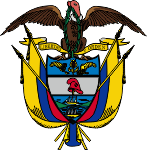
Wappen von Kolumbien,
Quelle: Corel Draw 4

Das Staatswappen stammt in seinen Grundstrukturen aus dem Jahre 1832, wurde jedoch immer wieder – zuletzt im Jahre 1955 – leicht abgeändert. Es zeigt auf einem von Flaggen umgebenen Schild zwei Füllhörner, einen Granatapfel und eine phrygische Mütze, darunter die Landenge von Panama, die bis 1903 zu Kolumbien gehörte. Der Granatapfel erinnert an den früheren Landesnamen "Neugranada". Oberhalb des Schilds ein Kondor, der Nationalvogel des Landes, und ein goldenes Spruchband mit dem Landesmotto: "Libertad y Orden" → "Freiheit und Ordnung"
Quelle:
Flaggen Wappen Hymnen

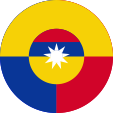
1927–1953,
Flugzeugkokarde,
Quelle, nach: Wikipedia (EN)
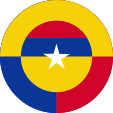
seit 1953,
Flugzeugkokarde,
Quelle, nach: Wikipedia (EN)

Lage:
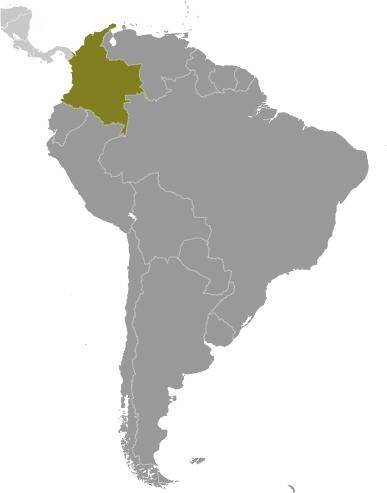
Quelle: CIA World Factbook
Landkarte des Landes:
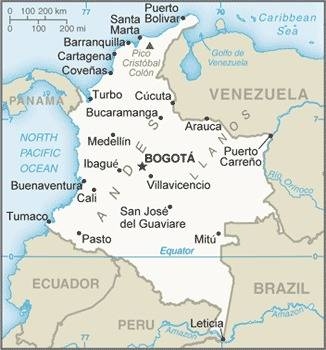
Quelle: CIA World Factbook

Fläche: 1.141.748 km²
Einwohner: 50.900.000 (2020), davon 47% Mestizen, 40% Europäer, 7% Afro-Amerikaner und Mulatten, 4% Indianer
Religionen: 70% Katholiken, 20% Evangelikale
Bevölkerungsdichte: 45 Ew./km²
Hauptstadt: Bogotá (früher: Santa Fé de Bogotá), 7.901.653 Ew. (2022)
Amtssprache: Spanisch
sonstige Sprachen: kreolisches Englisch, Indiosprachen
Währung: 1 Kolumbianischer Peso (COP, col$) = 100 Centavos
Zeitzone: MEZ – 6 h
Quelle: Wikipedia (D)

ca. 200 v.Chr.–ca. 500 n.Chr · Calima-Kultur im zentralen Bergland
ca. 1000 n.Chr.–ca. 1600 · Tairona-Kultur im Norden des Landes
1499 · der Spanier Alonso de Ojeda entdeckt die Küste Kolumbiens
1505 · Beginn der Spanischen Erkundung
1525 · Beginn der spanischen Kolonisierung
1528–1556 · der Norden des heutigen Venezuela ist im Besitz der deutschen Familie Welser
1536–1539 · Spanien erobert ganz Kolumbien und zerstört 1538 das Reich der Chibcha im Hochland
1739 · Bildung des Vizekönigreichs Neugranada, welches die heutigen Staaten Kolumbien, Venezuela, Ekuador und Panama umfasst
1781 · großer anti-spanischer Aufstand
20.07.1810 · Proklamation der Unabhängigkeit von Spanien
1810–1819 · Unabhängigkeitskrieg gegen Spanien unter der Führung von Simón Bolívar
1819 · Proklamation der Republik Großkolumbien (ehemaliges Vizekönigreich Neugranada)
1830 · Venezuela und Ekuador spalten sich durch Bürgerkriege von Großkolumbien ab, Großkolumbien wird in Republik Neugranada umbenannt
1856 · militärische Intervention der USA
1858 · die Republik Neugranada wird in Granadische Konföderation umbenannt
1860 · militärische Intervention der USA
1861 · Proklamation der Vereinigten Staaten von Kolumbien
1885 · militärische Intervention der USA
1886 · Proklamation der Republik Kolumbien
1891–1896 · Grenzstreitigkeiten mit Venezuela
1895 · militärische Intervention der USA
1899–1903 · Bürgerkrieg
1901–1902 · militärische Intervention der USA
1903 · die Provinz Panama spaltet sich auf Betreiben der USA von Kolumbien ab und erklärt ihre Unabhängigkeit
1921 · Kolumbien erkennt die Unabhängigkeit von Panama an
1931–1942 · Grenzstreitigkeiten mit Peru
1948–1953 · Bürgerkrieg („violencia“)
1953–1957 · Militärdiktator unter G. Rojas Pinilla
1965–2004 · Bürgerkrieg zwischen rivalisierenden Milizen, den kommunistischen Gruppen FARC und ELN, Drogenkartellen und der Regierung
1991 · neue Verfassung
2016/2017 · Versuche von Friedensabkommen zwischen der Regierung und FARC und ELN
Quelle:
Atlas zur Geschichte,
Wikipedia (D),
Discovery '97,
Weltgeschichte

Der Name des Landes ist eine Reminszenz auf Christoph Kolumbus, der im Jahre 1492 Amerika entdeckt hat.
Quelle: Handbuch der geographischen Namen


![]()

























































